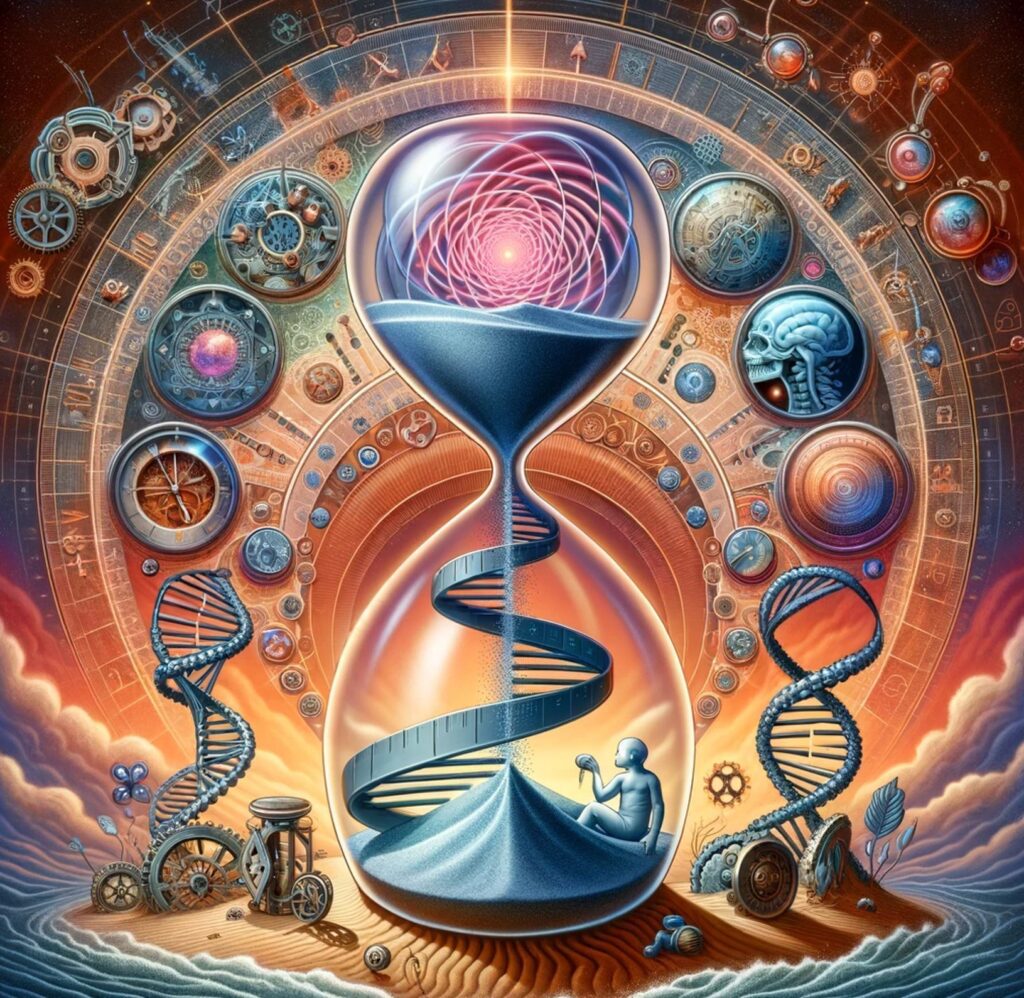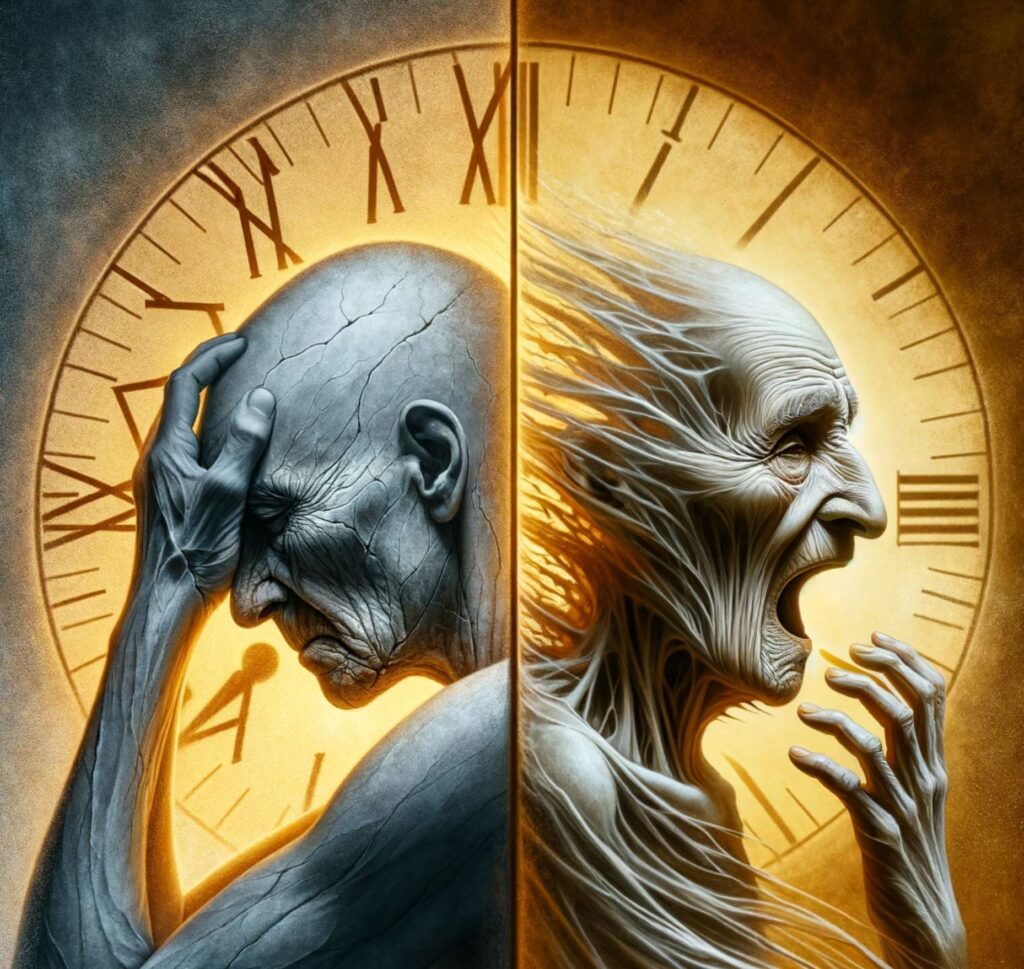In 1957, biologist G.C. Williams wrote: “It is truly amazing that a complex organism, formed through an extraordinary process of morphogenesis, should be unable to perform the much simpler task of merely maintaining what already exists”.
Soon after, it was discovered that sometimes two very closely related species (e.g., two species of closely related prairie voles) have vastly different lifespans despite being genetically remarkably similar. Gradually, the idea was born that some features of aging may be pre-programmed.

Programmed aging refers to the idea that some complex organisms have evolved biological mechanisms that purposely limit their lifespan beyond a certain species-specific age range because limiting an individual’s lifespan seems to be an evolutionary advantage for its genetic material. How come?
For a long time, it was assumed that aging and death produce no benefit for the individual and, therefore, under classical Darwinian evolution programmed aging should not exist. However, sometimes it is not just individuals who are under selective pressure, but whole populations.
For example, let’s say we have a couple of human tribes. In some tribes, all members are extremely selfish, while in other tribes members are more altruistic and they are actively cooperating and sharing resources. While selfishness is good for the individual in the short term, whole tribes composed of selfish individuals may die out because their members fail to cooperate.
The most successful tribes are the ones in which most individuals are altruistic. Even though selfishness does increase individual fitness in the short term, without altruism and cooperation, humans may not have been as able to effectively hunt down large animals by cooperative hunting, they may not have been able to defend each other from predators, or they may not have shared enough resources necessary to maintain population size resulting in extinction vortices caused by little genetic variability.
In this instance, evolution happens at a supra-individual level, namely at the level of whole groups (e.g., altruistic tribes have greater reproductive success than selfish tribes).

Now, let’s consider a similar example. Let’s say we have two groups of rabbits. One group in which rabbits have slow aging and a long lifespan and one group in which rabbits have fast aging and a short lifespan.
Let’s say that both groups experience repeated viral outbreaks. The slow-aging-long-lifespan group dies out quite soon because the group as a whole cannot keep up with the evolutionary arms race against the viruses.
However, in the fast-aging-short-lifespan population of rabbits individuals reach reproductive age more quickly. This leads to a faster in-group reshuffling of HLA-alleles and other genetic adaptations, which make the descendants much better adapted to keep the upper hand in the fight against viruses because the group as a whole evolves more quickly.
In this instance, a long lifespan is not just unnecessary (because the viral outbreaks kill the rabbits long before natural aging would do so), but an active handicap to passing on the rabbits’ genetic material. In this example, it is obvious how fast aging could be beneficial for a group (or species) even though it produces a cost to the individual.

Because a species with a long lifespan evolves much more slowly and is therefore not able to adapt fast enough to strong evolutionary pressures (e.g., whether it be viruses, starvation, predation, etc.), some researchers hypothesize that extremely long lifespans were a reproductive handicap, and therefore long-lifespan species are naturally selected against.
In evolutionary biology, this concept is known as “evolvability” and it could very well be that impaired evolvability is the reason there are no (or only very few) species around with very slow aging (which would also mean that they reach reproductive years later).
If this is the case, genes coding for molecular programs actively driving the aging process would promote colony fitness, and thus could have become part of the standard genetic blueprint and conserved by evolution.
A promising mechanism that could explain parts of programmed aging is the overactivity of the mTOR pathway. This pathway causes growth, maturity, and cellular senescence.
While some argue that the mTOR pathway is an evolved mechanism to drive aging on purpose, others (me included) believe that the pro-aging effects of it are just an unintended consequence of a system that was awesome for the young, while not caring about the old.
Whatever the case, we now have tools to target it. Lowering the activity of the mTOR pathway increases lifespan, delays cellular aging (e.g., inflammation, cellular senescence), and ameliorates age-related disease. More info on this in Part IV: My Longevity Protocol
Does programmed aging exist?
There are many examples of “programmed” suicide in nature. For example, some butterflies degenerate their digestive tract upon metamorphosis, or certain spiders self-sacrifice to be devoured by their offspring. However, this programmed suicide has little to do with programmed premature aging.
Even though it is conceivable that programmed aging exists, it is equally conceivable that the concept of programmed aging is of negligible real-world importance and the different aging rates between closely related species are explained by one species having evolved to invest much more energy into costly repair processes than the other.
For example, let’s consider the two species of prairie voles mentioned above. It turns out that one of these species lives in a habitat with much more predation, therefore having evolved a much greater cortisol secretion. Cortisol gives physical energy, mental alertness, and nutrient mobilization, all of which are beneficial in times of stress (or in a stressful environment).
However, at high doses/levels, cortisol has pro-aging effects on every cell of the body due to changing the expression of a number of genes involved in cellular repair, growth, and autophagy. It is hypothesized that the different rates of cortisol secretion account for most of the different aging rates.
And similar things are true for humans. Speculatively, this may have been part of the reason why the body of 39-year-old Martin Luther King Junior reportedly looked like the body of a 70-year-old during autopsy. Due to the intense pressure he was under, his adrenals had probably been secreting vast amounts of cortisol for years. There is a reason for the saying that “stress can kill you”. Well, it is not the “stress”, but rather the associated hypercortisolemia.

More generally, if one species has more predators than the other, individuals of that species usually die much earlier because investing a lot of energy into fighting natural aging would be a waste of resources that would be better spent elsewhere.
In other words, it could be that evolution does not limit a species’ lifespan on purpose, but natural selection rather decides how much energy should be invested into fighting entropy to keep individuals around for longer.
Subscribe to the Desmolysium newsletter and get access to three exclusive articles!
So, why do we age?
Is aging purely a byproduct of being alive or is aging pre-programmed?
It is conceivable (and mechanistically plausible) that programmed aging is indeed a specially evolved feature for a handful of species in the same way that antlers are a specially evolved feature of a handful of species. If the necessary evolutionary pressures are there, evolution can hand out antlers more widely, but for most species, the necessary evolutionary pressures are not there.
There are no rules for evolution other than physical laws. If programmed aging is adaptive for a certain species, there are many potential candidate molecular mechanisms to program it. However, whether programmed aging exists, is currently unknown.
I personally believe that most of the aging we humans experience is natural aging, and that programmed aging is of very minor importance to both humans as well as most other species.
Even if there is a programmed component, there would still be some additional, unprogrammed degeneration (i.e., natural aging) on top of that. For example, the progressive accumulation of waste, the stochastic loss of stem cells, and the accumulation of senescent cells would happen naturally regardless of programmed aging.
Whatever the case, aging is polyfactorial, spontaneous, happens in everyone, and is unavoidable. However, the rate of aging can be vastly negotiated by targeting multiple drivers at the same time – regardless of whether there is a programmed mechanism to it or not.
This article is an extension of How I Biohack My Longevity.

Sources & further information
- Scientific article: Evolution of Aging Theories: Why Modern Programmed Aging Concepts Are Transforming Medical Research
- Scientific article: Programmed Aging of Mammals: Proof of Concept and Prospects
- Scientific article: Can Aging Be Programmed?
Disclaimer
The content available on this website is based on the author’s individual research, opinions, and personal experiences. It is intended solely for informational and entertainment purposes and does not constitute medical advice. The author does not endorse the use of supplements, pharmaceutical drugs, or hormones without the direct oversight of a qualified physician. People should never disregard professional medical advice or delay in seeking it because of something they have read on the internet.
